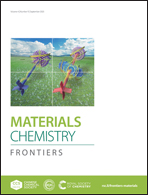An aromatic carbonyl compound-linked conjugated microporous polymer as an advanced cathode material for lithium-organic batteries†
Abstract
Conjugated microporous polymers are emerging as promising materials for lithium ion batteries (LIBs) because of their permanent and controlled porosity, high surface areas, and tunable structures. Herein, an aromatic carbonyl compound-linked conjugated microporous polymer based on pyrene-4,5,9,10-tetraone (PT-BTA) is synthesized by Suzuki coupling reaction. Profiting from the extended conjugation structure, the as-obtained PT-BTA polymer shows good cycling stability and high electronic conductivity compared with the PT monomer. When explored as a cathode material for LIBs, PT-BTA shows enhanced electrochemical performance, including a high capacity (166.7 mA h g−1 at 0.05 A g−1), stable cycling (70.1% capacity retention after 500 cycles at 0.2 A g−1), and excellent rate capability (93.1 mA h g−1 even at 1 A g−1). Furthermore, theoretical calculations and comprehensive characterizations are proposed to deeply understand the Li+ storage mechanisms. Our work may offer a rational molecular design strategy for the construction of organic-based next generation sustainable energy storage systems.



 Please wait while we load your content...
Please wait while we load your content...